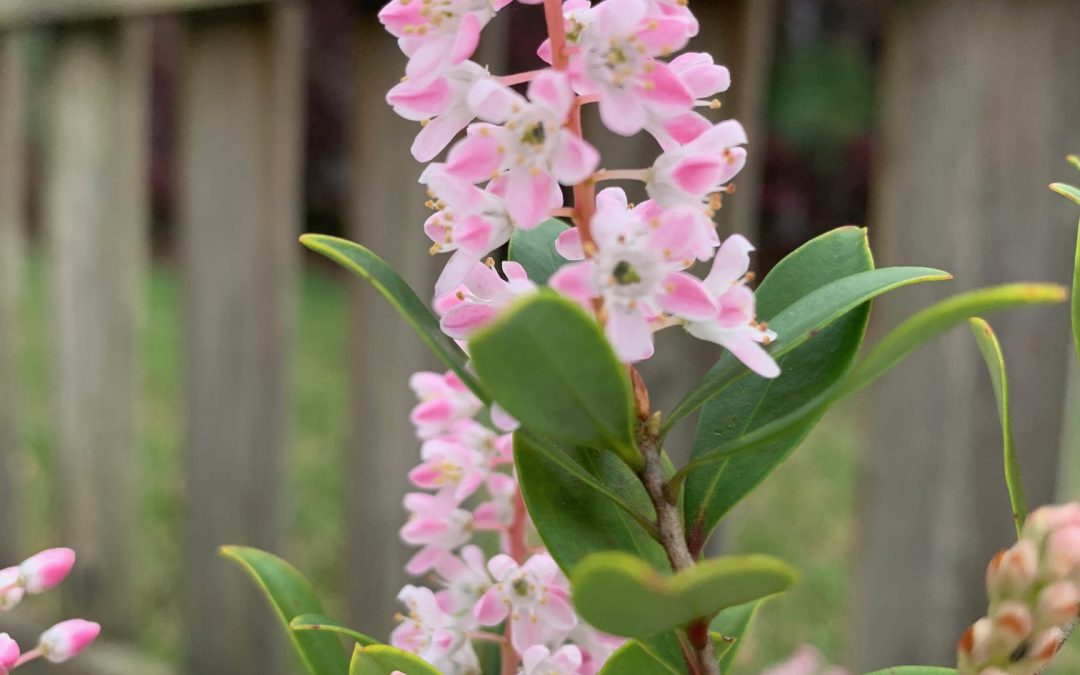
by Mary Salinas | Feb 18, 2020
Florida is home to some amazing and gorgeous plants that are underused and underappreciated in the home landscape. One such plant is an evergreen and easy-care large shrub or small tree known as black titi or buckwheat tree, botanically known as Cliftonia monophylla.
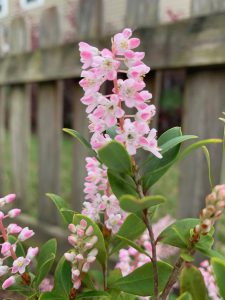
Pink-flowered variety of black titi, Cliftonia monophylla. Photo credit: Mary Salinas, UF/IFAS Extension.
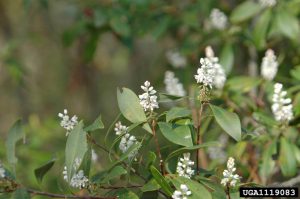
Black titi or buckwheat tree. Photo credit: Chris Evans, University of Illinois, bugwood.com
Black titi is commonly found in wet areas and at the edges of swamps in USDA hardiness zones 7B through 9A from Louisiana through the Florida panhandle and into South Carolina. This is a perfect plant for those areas of your landscape that are low and consistently moist.
Early spring brings clusters of small white flowers at the tips of the branches. Occasionally one can find the pink-flowered variety of black titi in the native nursery trade. These fragrant flowers provide an early season nectar source for bees in February and March. The flowers give way to golden-amber seed pods that resemble buckwheat. The seed pods turn a pleasing orange-brown and persist on the plant through winter. The shiny dark green evergreen leaves along with the seed pods provide an additional ornamental quality to the tree in fall and early winter.
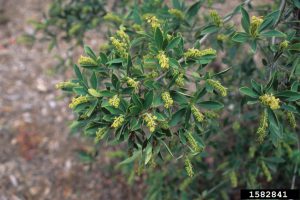
Black Titi golden-amber fruit. John Ruter, University of Georgia, bugwood.org
For more information:
Florida Honey Bee Plants
USDA Plant Database
Florida Native Plant Society
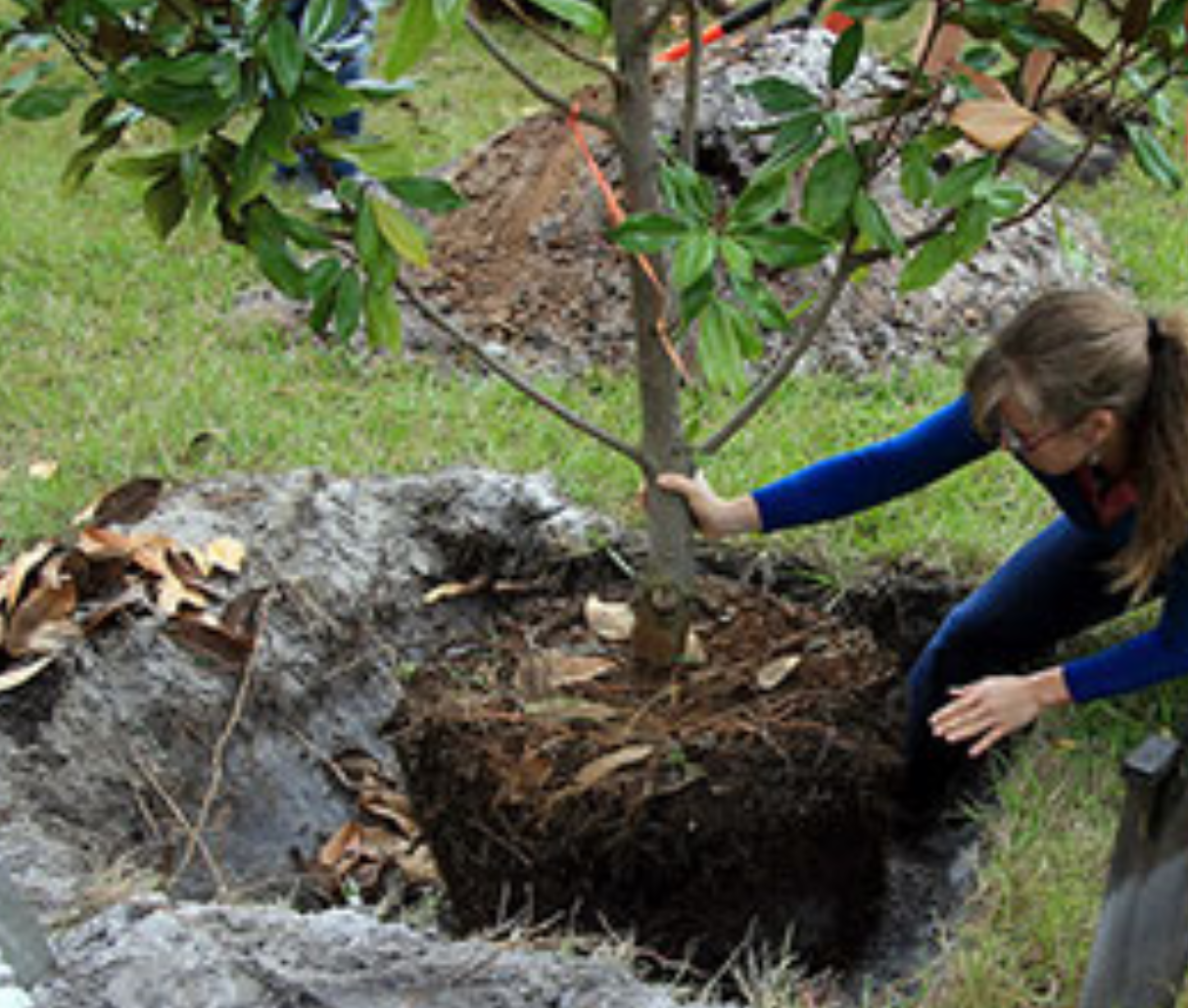
by Carrie Stevenson | Jan 22, 2020
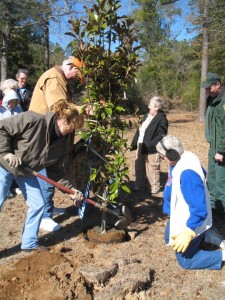
Master Gardeners demonstrate correct tree planting techniques.
Last week, we celebrated Florida’s Arbor Day. “What?” you may say—“Isn’t Arbor Day in the spring?” Well, yes and no. National Arbor Day is celebrated in the spring (April 24 this year), usually within a day or two of Earth Day. However, because of the wide range of climatic environments throughout the United States, each state has its own date based on ideal growing conditions. As it stands, Florida’s is the 3rd Friday in January, as we are situated so very far south. Alabama and Georgia, where so many of us north Floridians experience similar weather, hold their Arbor Days in late February.
Contrary to popular opinion, the optimal planting time for trees is not in the spring, but in fall and winter. Planting during dormancy allows trees to focus their energy resources on growing healthy roots. In the coming spring, a steady supply of warmth, sunshine, and pollinators will bring on leaf growth, flowers, and fruit.
Check with your local Extension offices, garden clubs, and municipalities to find out if there is an Arbor Day event near you! Several local agencies have joined forces to organize tree giveaway events and sales in observance of Florida’s Arbor Day.
Saturday, January 25th
Leon County: UF/IFAS Extension Leon County Master Gardeners will assist with the county’s Arbor Day tree planting at 9 a.m. Martha Wellman Park, 5317 W. Tennessee St., Tallahassee.

by Matt Lollar | Jan 13, 2020
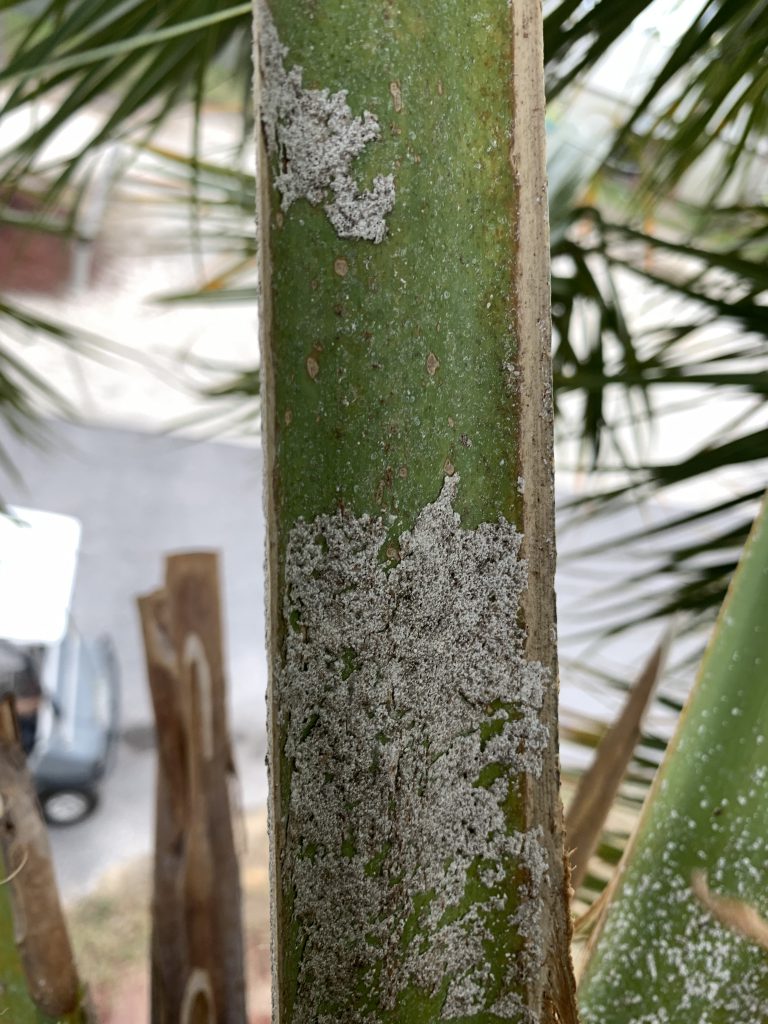
Scale insects on a cabbage palm (Sabal palmetto). Photo Credit: Matt Lollar, University of Florida/IFAS Extension – Santa Rosa County
This week I was on a couple site visits to look on some cabbage palms (Sabal palmetto) and some banana shrubs (Michelia figo). The palms had a white, waxy substance on their frond petioles and the banana shrubs had white specs on the tops of their leaves. Upon further investigation, I realized the waxy substance and specs were both different species of scales. Scale insects are serious pests of a number of ornamental plants. Here in Florida there are 13 different families of scales with the most common being armored scales, soft scales, and mealybugs. Scales have piercing-sucking mouthparts which they use to siphon fluids from the leaves, stems, and sometimes roots of many ornamental plants. Heavy infestations cause extensive leaf yellowing, premature leaf drop, branch dieback, and eventually plant death.
Scale Biology
The life cycle of a scale begins with eggs being laid beneath wax coverings or beneath the adult female. Eggs typically hatch in 1 to 3 weeks. The newly hatched nymphs, called crawlers, move around a plant until they find a spot to feed. Once a feeding site is located, their piercing sucking mouthparts are inserted into the plant and the crawlers begin to feed and grow. The males of many scale species develop wings as adults and fly to other plants to reproduce.
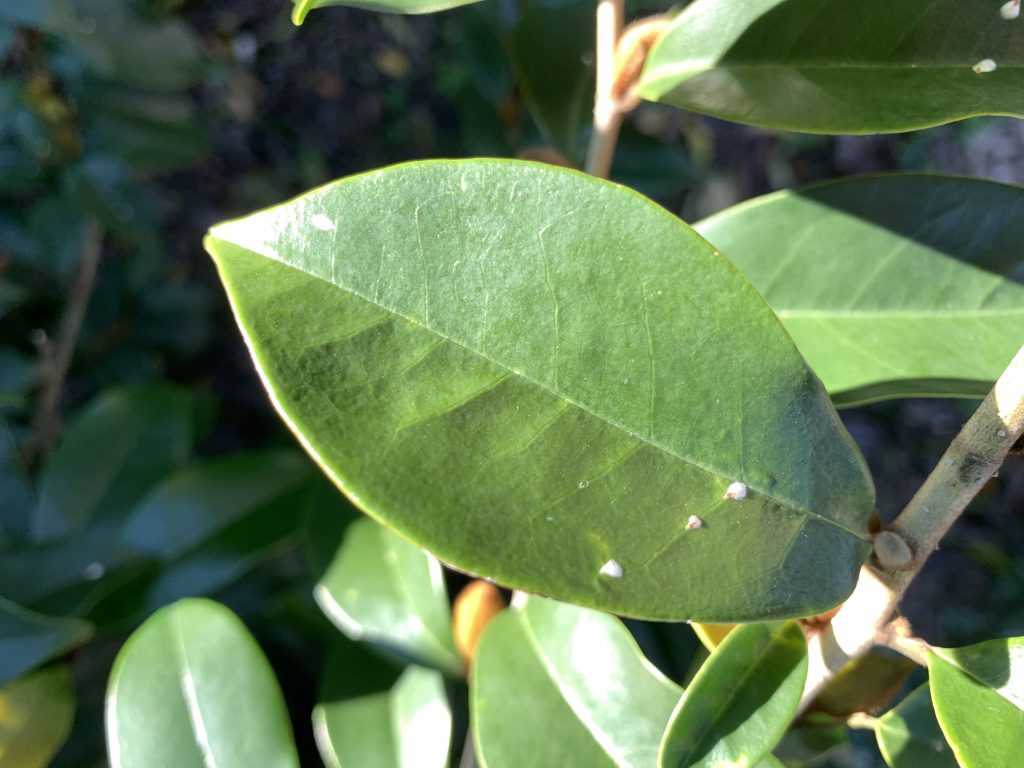
Magnolia white scales on a banana shrub (Michelia figo). Photo Credit: Matt Lollar, University of Florida/IFAS Extension – Santa Rosa County
Armored Scales
Armored scales get their armor by secreting a waxy covering over their bodies that is not attached. The scale lives under this covering and uses it as a protection to feed under. Armored scales can be almost any color or shape and range anywhere from 1/16 to 1/8 inch in diameter. For females, these shapes range from circular to oval to long and slender. The males typically have coverings that are more elongate and smaller than the females. As adults, the males are tiny, winged, gnat-like insects and are rarely seen.
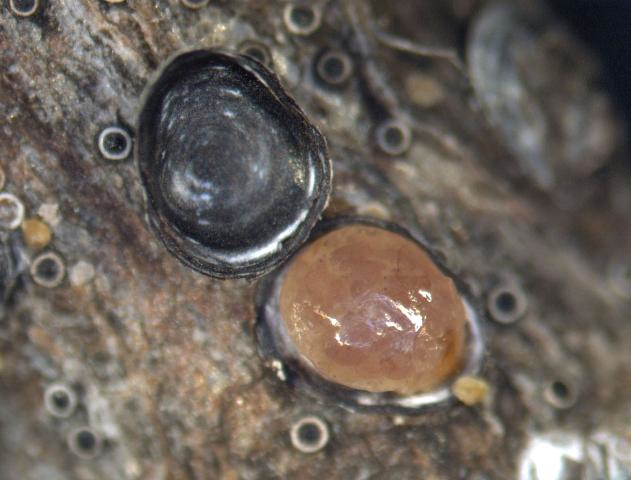
Gloomy scale (Melanaspis tenebricosa) with armored covering removed. Photo Credit: A. G. Dale, University of Florida/IFAS
Soft Scales
Similar to armored scales, soft scales secrete a waxy covering, but it is attached to their bodies. Soft scales can be a number of colors, shapes, and sizes and range anywhere from 1/8 to 1/2 inch in diameter. Their shapes vary from spherical to nearly flat.

Population of adult and immature tuttle mealybugs (Brevennia rehi) on a blade of zoysiagrass. Photo Credit: Lyle J. Buss, University of Florida/IFAS
Mealybugs
Mealybugs are soft-bodied insects that possess a covering of flocculent, white, waxy filaments. They are about 1/8 inch in length and usually pinkish or yellowish in color. Mealybugs have piercing-sucking mouthparts which they use to siphon fluids from the leaves, stems, and sometimes roots of many ornamental plants. Mealybug damage produces discolored, wilted, and deformed leaves.
Scale and Mealybug Management
- Cultural Control – Plant inspection prior to purchase or installation is the first line of defense against a scale or mealybug population. Make sure to inspect the undersides of leaves and plant stems. Infested sections of plants can be pruned and plant material should be cleaned from the planting area and discarded. Also, you can increase air flow and decrease humidity by proper installation and pruning. Over-fertilizing can also increase pest populations.
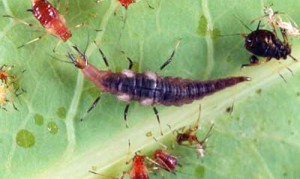
Larva of a brown lacewing. Credits: Lyle Buss, University of Florida.
- Biological Control – Predators, such as ladybugs and green lacewings, are usually present in large enough numbers to suppress scales and mealybugs to a desirable threshold. However, broad-spectrum insecticides and bad weather can reduce predator numbers. Look for signs of predation by inspecting dead scales for jagged holes in their waxy coatings. If predation signs are present, use more selective chemical controls and oils as opposed to broad-spectrum products.
- Chemical Control – Timing is everything when it comes to managing scale and mealybug insects. Crawler activity is more pronounced with the flush of new plant growth in the spring. Before application, prune infested plant parts off first to promote greater penetration of insecticides into the foliage. Dormant Oils are often used in the winter to smother scale insects. These are good choices to implement because they don’t harm non-target or beneficial insects. Care must be taken to read the label and use them at the correct temperature, since use in hot weather may burn foliage. Contact products (acephate, bifenthrin, carbaryl, etc.) must be applied to inhibit the crawler stages of these insects and systemic products (acetamiprid, imidacloprid, thiamethoxam, etc.) can be used on the sessile growth stage. Plants should be sprayed thoroughly to the point of drip or “run off” from leaves, twigs, and stems. Repeated applications may still be necessary even if the timing is right, as crawler populations are often large and crawlers like to hide under old waxy scales. Systemic drenches are also a viable option. With good spray coverage, horticultural oils can kill scales at all stages of growth. Refer to the product label for phytotoxicity and temperature guidelines. Even after successful treatment, the outer coatings of the scales may remain on the plant material for weeks, which can be unsightly. The best way to determine if scales are dead is to squeeze them. They will be dry when squeezed if they are dead and they will ooze liquids if they are living (they were at least alive to the point of being squashed).
For insect identification and additional information on scale control, please see:
A Guide to Scale Insect Identification
UF/IFAS Featured Creatures
Your County Extension Office
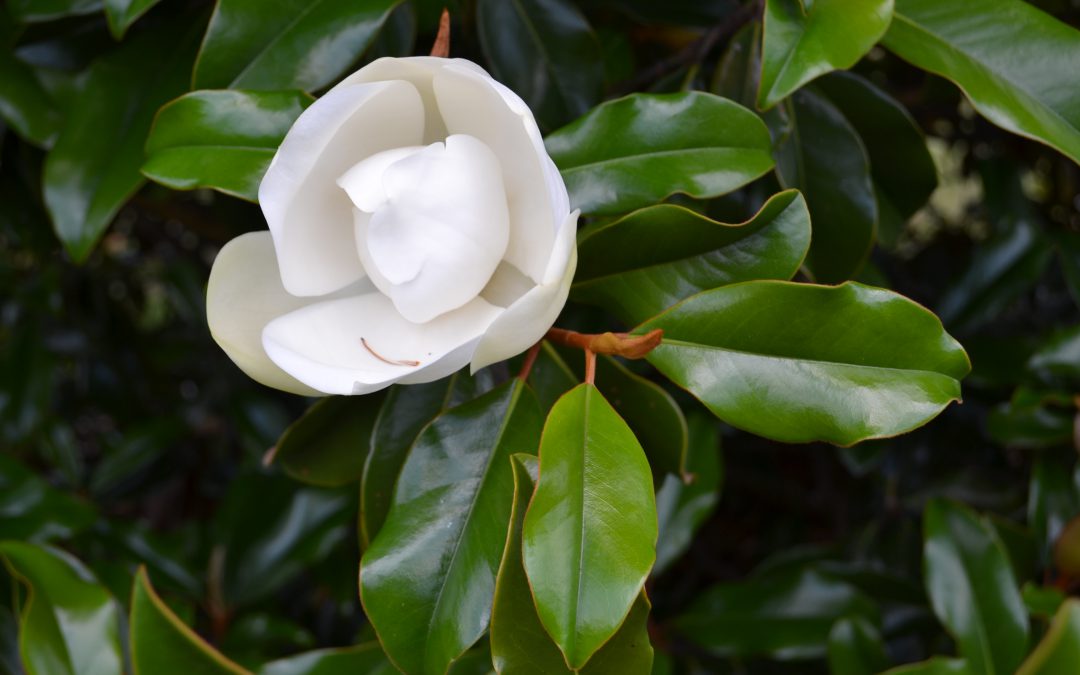
by Beth Bolles | Jan 13, 2020
The Southern magnolia (Magnolia grandiflora) has always been a favorite tree since it is associated with my childhood home in Tennessee. I always enjoyed the evergreen leaves and large white flowers. In my parent’s yard, the southern magnolia had branches to the ground that allowed the large leaves to stay hidden in a self- mulching area. I never recall the tree begin called messy because of this growth style.
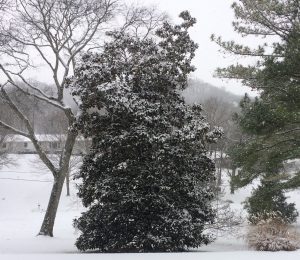
A Southern Magnolia in a Tennessee winter. Photo by Beth Bolles, UF IFAS Extension Escambia County
Many landscapes today may not have room for a southern magnolia that can grow an average of 60 feet in height with an average spread of 25 feet. Because it’ qualities are still desirable, nursery professionals have developed southern magnolia cultivars that are very popular as landscape features due to different growth habits, leaf sizes, and hardiness to our area’s weather. Although the cultivars will be different from the old favorite southern magnolia in growth form and size, homeowners should still do their homework to make sure trees are located in spots for plants to reach proper height and width growth. Also, like I mentioned for my parent’s tree, many of the new cultivars look best if the lower limbs are not removed.
If you or your landscaper are considering a Southern magnolia cultivar, here are a few details about some you may find available.
‘Little Gem’ dwarf southern magnolia has been the go-to magnolia for new landscapes. The dark green leaves are smaller and the plant will be more compact than the traditional southern magnolia. It is often misplaced in landscapes because of these features. Trees still grow about 25 feet high with a spread of 15 feet.
‘Bracken’s Brown Beauty’ is a very attractive magnolia when given room to grow. Foliage is very attractive with shiny green above and brown on the undersides. This plant can grow 40 to 50 feet in height with a spread averaging 20 feet. Plan not to prune lower limbs to maintain a beautiful form.
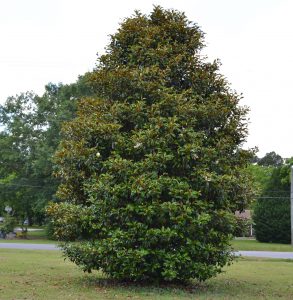
Bracken’s Brown Beauty as an accent tree in a lawn area. Photo by Beth Bolles, UF IFAS Extension Escambia County
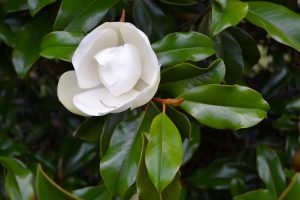
Bracken’s Brown Beauty flower. Photo by Beth Bolles, UF IFAS Extension Escambia County
‘Southern Charm’ magnolia, registered as Teddy Bear is also a compact plant. It grows upright to about 20 feet with a spread about 15. You still have the beautiful green and brown leaf color along with 6 inch wide flowers.
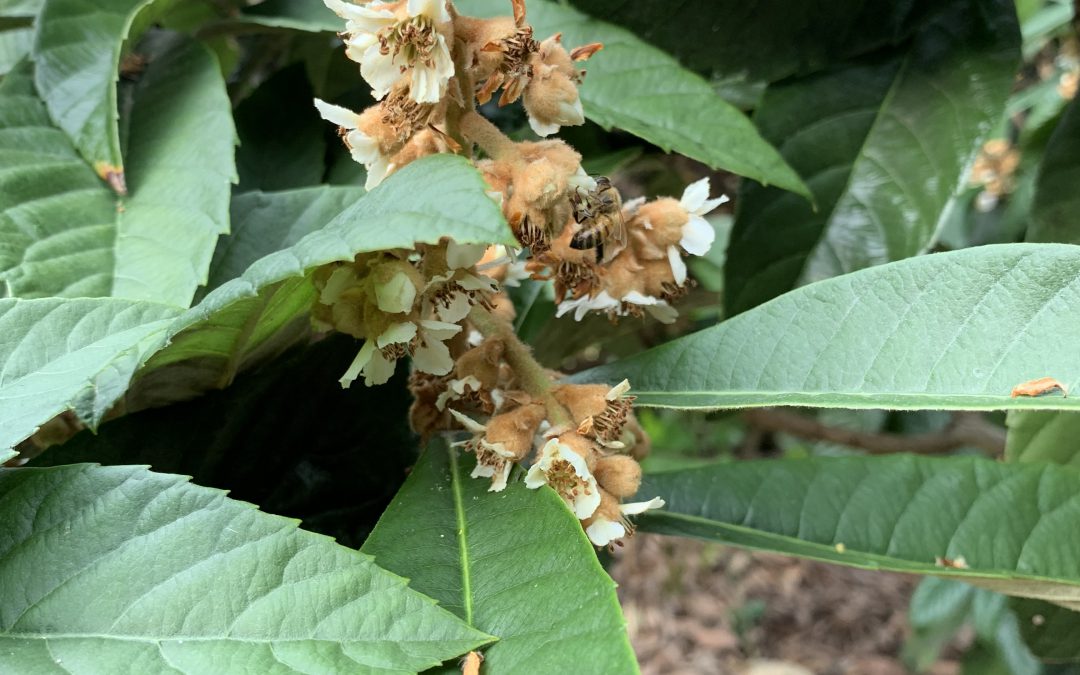
by Matt Lollar | Dec 10, 2019
Loquat trees provide nice fall color with creamy yellow buds and white flowers on their long terminal panicles. These small (20 to 35 ft. tall) evergreen trees are native to China and first appeared in Southern landscapes in the late 19th Century. They are grown commercially in subtropical and Mediterranean areas of the world and small production acreage can be found in California. They are cold tolerant down to temperatures of 8 degrees Fahrenheit, but they will drop their flowers or fruit if temperatures dip below 27 degrees Fahrenheit.
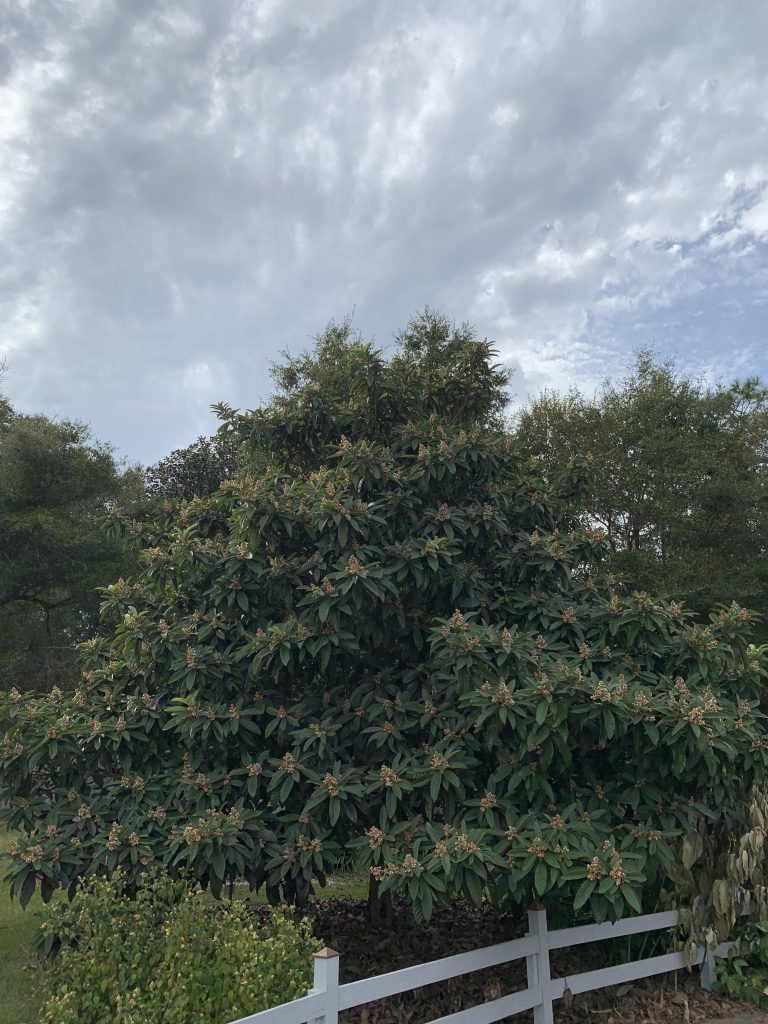
A beautiful loquat specimen at the UF/IFAS Extension at Santa Rosa County. Photo Credit: Matt Lollar, University of Florida/IFAS – Santa Rosa County
Leaves – The leaf configuration on loquat trees is classified as whorled. The leaf shape is lanceolate and the color is dark green with a nice soft brown surface underneath. These features help give the trees their tropical appearance.
Flowers – 30 to 100 flowers can be present on each terminal panicle. Individual flowers are roughly half an inch in diameter and have white petals.
Fruit – What surprises most people is that loquats are more closely related to apples and peaches than any tropical fruit. Fruit are classified as pomes and appear in clusters ranging from 4 to 30 depending on variety and fruit size. They are rounded to ovate in shape and are usually between 1.5 and 3 inches in length. Fruit are light yellow to orange in color and contain one to many seeds.

A cluster of loquat flowers/buds being pollinated by a honey bee. Photo Credit: Matt Lollar, University of Florida/IFAS – Santa Rosa County
Propagation – Loquat trees are easily propagated by seed, as you will notice as soon as your tree first bears fruit. Seedlings pop up throughout yards containing even just one loquat tree. It is important to note that the trees do not come true from seed and they go through a 6- to 8-year juvenile period before flowering and fruiting. Propagation by cuttings or air layering is more difficult but rewarding, because vegitatively-propagated trees bear fruit within two years of planting. Sometimes mature trees are top-worked (grafted at the terminal ends of branches) to produce a more desirable fruit cultivar.
Loquat trees are hardy, provide an aesthetic focal point to the landscape, and produce a tasty fruit. For more information on growing loquats and a comprehensive list of cultivars, please visit the UF EDIS Publication: Loquat Growing in the Florida Home Landscape.

by Larry Williams | Dec 4, 2019
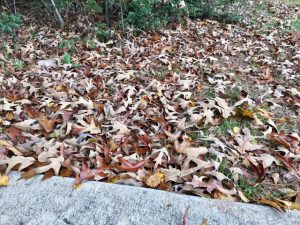
Fall oak tree leaves abound and can be recycled as landscape mulch. Photo credit: Larry Williams
Weed control is not top on my list as a reason to use mulch. There are weeds that can push through mulch such as nutsedge (nutgrass) or that can germinate and grow in the mulch. But done correctly, mulching plant beds and gardens can help inhibit some weeds. Tree leaves can be used as a mulch.
In addition to weed control, mulch provides other benefits. It can make landscapes look more attractive. It keeps roots evenly moist, acts to insulate roots from extreme heat and cold and can help decrease loss of soil from wind and water erosion. Mulch serves as a barrier to some soil-borne diseases, especially in the vegetable garden. And, as organic mulch breaks down, it improves the soil’s fertility, aeration, structure and drainage.
Tree leaves make good mulch. They can be placed on the soil surface beneath and around shrubs, trees, perennials, annuals and vegetables.
Fall leaves are abundant. Some people feel overwhelmed by the volume. One resident reported raking more than 100 large bags of leaves from his half-acre property. One large oak tree can contain over 250,000 leaves!
Tree leaves can be placed in landscape beds or around vegetables “as is” or chopped up with a shredder or mower into smaller pieces and then spread around vegetables, shrubs and trees. Mixing leaves from several different species of trees can make better leaf mulch. Leaves of the same size tend to mat together and produce a shingling effect that can shed water and reduce gas exchange in the soil. Shredded leaves stay seated better on the landscape than whole leaves.
A mulch layer three inches deep after settling is enough for most plants. If possible, extend the mulched areas out to the outermost leaves (called the drip line) and beyond. And be sure to pull the mulch back a few inches from the main trunk. Never pile mulch around the trunk.
Using those fallen tree leaves as mulch recycles a natural resource and saves you money, enriches your soil, fertilizes your plants and keeps them out of the local landfill.
So, instead of putting all those leaves curbside in plastic bags to be hauled off, use them to benefit your landscape, which may include less weeds.
For additional information on landscape/garden mulch, contact the UF/IFAS Extension Office in your County or access the following sites.
http://gardeningsolutions.ifas.ufl.edu/care/planting/mulch.html
http://edis.ifas.ufl.edu/topic_mulch





















